
Bubalus is a genus of Asiatic bovines that was proposed by Charles Hamilton Smith in 1827. Bubalus and Syncerus form the subtribe Bubalina, the true buffaloes.

The Bovidae comprise the biological family of cloven-hoofed, ruminant mammals that includes cattle, yaks, bison, buffalo, antelopes, sheep and goats. A member of this family is called a bovid. With 143 extant species and 300 known extinct species, the family Bovidae consists of 11 major subfamilies and thirteen major tribes. The family evolved 20 million years ago, in the early Miocene.

The four-horned antelope, or chousingha, is a small antelope found in India and Nepal. Its four horns distinguish it from most other bovids, which have two horns. The sole member of the genus Tetracerus, the species was first described by French zoologist Henri Marie Ducrotay de Blainville in 1816. Three subspecies are recognised. The four-horned antelope stands nearly 55–64 centimetres (22–25 in) at the shoulder and weighs nearly 17–22 kilograms (37–49 lb). Slender with thin legs and a short tail, the four-horned antelope has a yellowish brown to reddish coat. One pair of horns is located between the ears, and the other on the forehead. The posterior horns are always longer than the anterior horns, which might be mere fur-covered studs. While the posterior horns measure 8–12 centimetres (3.1–4.7 in), the anterior ones are 2–5 centimetres (0.79–1.97 in) long.
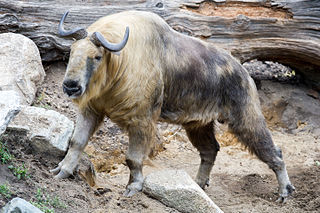
The takin, also called cattle chamois or gnu goat, is a large species of ungulate of the subfamily Caprinae found in the eastern Himalayas. It includes four subspecies: the Mishmi takin, the golden takin, the Tibetan takin, and the Bhutan takin.
Hadar or Hadar Formation is a paleontological fossil site located in Mille district, Administrative Zone 1 of the Afar Region, Ethiopia, 15 km upstream (west) of the A1 road's bridge across the Awash River.

Syncerus is a genus of African bovid that contains the living Cape buffalo (Syncerus caffer), including the distinct African forest buffalo.

Budorcas is a genus of bovid that contains a single living species, the takin (Budorcas taxicolor). Two extinct species are known from the Pliocene, B. teilhardi from China and B. churcheri from Ethiopia. The presence of the genus in Africa indicates that it was far more widespread in the past.

Pliohyrax, is a genus of hyracoids. It grew to sizes greatly exceeding those of any living hyrax, though it was by no means the largest member of this family.

The tribe Bovini, or wild cattle, are medium to massive bovines that are native to Eurasia, North America, and Africa. These include the enigmatic, antelope-like saola, the African and Asiatic buffalos, and a clade that consists of bison and the wild cattle of the genus Bos. Not only are they the largest members of the subfamily Bovinae, they are the largest species of their family Bovidae. The largest species is the gaur, weighing up to 1,500 kg (3,300 lb).

The golden takin is a threatened subspecies of takin, native to the Qin Mountains in the south of China's Shaanxi province. There are four distinct subspecies of the Takin: Mishmi Takin, Sichuan Takin, Bhutan Takin/White's Takin, and Golden takin.
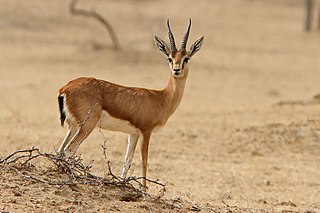
A gazelle is one of many antelope species in the genus Gazella. There are also seven species included in two further genera; Eudorcas and Nanger, which were formerly considered subgenera of Gazella. A third former subgenus, Procapra, includes three living species of Asian gazelles.
Damalborea is an extinct genus of alcelaphine bovid. It was first named by Alan W. Gentry in 2010, and the type species is Damalborea elisabethae. It is known from the holotype AL 208–7, a skull with horn cores collected from the Middle Pliocene Hadar Formation Member SH-3 of Ethiopia. In addition, a fossils of this or a closely related species were collected from Aramis, Wee-ee and Maka localities in the Middle Awash deposits, lower and upper units of the Laetolil Beds, as well as Tulu Bor Member and an unknown horizon of the Koobi Fora Formation. Geraads, Bobe & Reed (2012) assigned all Damalborea specimens from the Basal Member and Sidi Hakoma member of the Hadar Formation to the species D. elisabethae; in addition, the authors named the second species, Damalborea grayi, described on the basis of fossils from the Denen Dora member of the Hadar Formation. Damalborea was a moderately large alcelaphine with high and narrow skull proportions.

Soergelia is a genus of extinct ovibovine caprine that was common across Europe, North America and Asia in the Pleistocene epoch.
Shirley Cameron Coryndon (1926–1976) was a British paleontologist and authority on fossil hippopotami.

Ugandax is an extinct genus of bovines in the subtribe Bubalina that lived from the Miocene to the Pleistocene of Africa. Cladistic analyses suggest Ugandax represents an ancestral form of the African buffalo, Syncerus, and teeth assigned to Ugandax represent the earliest appearance of bovines in Africa.
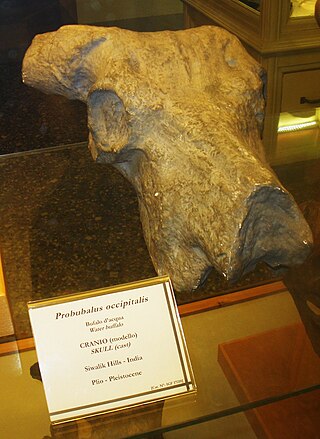
Hemibos is an extinct even-toed ungulate belonging to the family Bovidae. Its fossil remains were found across Asia and Europe such as from China, Italian Peninsula, Iberian Peninsula, and State of Palestine, Israel, Pakistan, India.
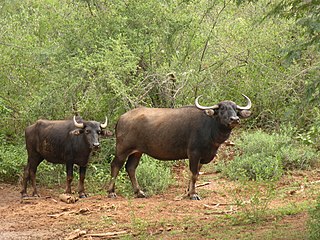
Bubalina is a subtribe of wild cattle that includes the various species of true buffalo. Species include the African buffalo, the anoas, and the wild water buffalo. Buffaloes can be found naturally in sub-Saharan Africa, South Asia and Southeast Asia, and domestic and feral populations have been introduced to Europe, the Americas, and Australia. In addition to the living species, bubalinans have an extensive fossil record where remains have been found in much of Afro-Eurasia.
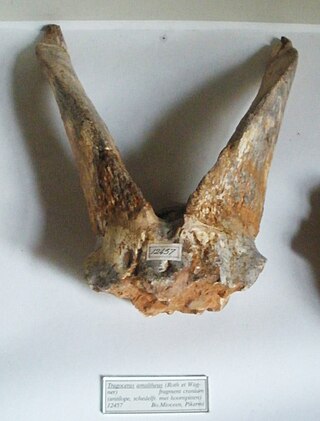
Tragoportax is an extinct genus of bovid ungulate. It lived during the upper Miocene, and its fossil remains have been found in Europe, Asia and Africa.
Damaliscus niro is an extinct species of antelope that lived in Africa throughout the Pleistocene, as recently as 63,000 years ago.
Bos buiaensis is an extinct species of cattle. The species is known from a million year old skull fossil found at the archaeological site of Buya, Eritrea in 2003. It was reassembled by excavators from over one hundred shards.













